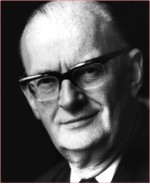| Author Profile

 Clarke's first professional sales appeared in Astounding Science Fiction in 1946: "Loophole" was published in April, and "Rescue Party", which was his first sale, was published in May. Along with his writing, Clarke worked briefly as Assistant Editor of Science Abstracts (1949) before devoting himself to writing full-time from 1951. Clarke also contributed to the Dan Dare series, and his first three published novels were for a juvenile audience. Clarke's first professional sales appeared in Astounding Science Fiction in 1946: "Loophole" was published in April, and "Rescue Party", which was his first sale, was published in May. Along with his writing, Clarke worked briefly as Assistant Editor of Science Abstracts (1949) before devoting himself to writing full-time from 1951. Clarke also contributed to the Dan Dare series, and his first three published novels were for a juvenile audience.
In 1948, he wrote "The Sentinel" for a BBC competition. Though the story was rejected, it changed the course of Clarke's career. Not only the basis for 2001, The Sentinel introduced a more mystical and cosmic element to Clarke's work. Many of Clarke's later works feature a technologically advanced but prejudiced mankind being confronted by a superior alien intelligence. In the cases of The City and the Stars, Childhood's End, and the 2001 series, this encounter produces a conceptual breakthrough that accelerates humanity into the next stage of its evolution.
In 1953 Clarke met and quickly married Marilyn Mayfield, a twenty-two year old American divorcee with a young son. They separated permanently after six months, although a divorce was not finalized until 1964.[3]
He has lived in Sri Lanka since 1956, immigrating when it was still called Ceylon, first in Unawatuna on the south coast, and then in Colombo. Clarke holds citizenship of both the UK and Sri Lanka.[4] He has long been an avid scuba diver and a member of the Underwater Explorers Club, and living in Sri Lanka has afforded him the opportunity to visit the ocean year-round. It also inspired the locale for his novel The Fountains of Paradise, in which he describes a space elevator. This, he believes, will ultimately be his legacy, more so than geostationary satellites, once space elevators make space shuttles obsolete.[5]
His many predictions culminated in 1958 when he began a series of essays in various magazines that eventually became Profiles of the Future, published in book form in 1962. A timetable[6] up to the year 2100 describes inventions and ideas including such things as a "global library" for 2005.
Early in his career, Clarke had a fascination with the paranormal, and has stated that it was part of the inspiration for his novel Childhood's End. He has also said that he was one of several who were fooled by a Uri Geller demonstration at Birkbeck College. Although he has long since dismissed and distanced himself from nearly all pseudoscience, he still advocates research into purported instances of psychokinesis and other similar phenomena.
In the early 1970s he signed a three-book publishing deal, a record for a science-fiction writer at the time. The first of the three was Rendezvous with Rama in 1973, which won him all the main genre awards and has spawned sequels that, along with the 2001 series, formed the backbone of Clarke's later career.
In 1975, his short story "The Star" was not included in a new high school English textbook in Sri Lanka because of concerns that it might offend Roman Catholics although it had already been selected. The same textbook also caused controversy because it replaced Shakespeare's work with that of Bob Dylan, John Lennon, and Isaac Asimov.
In the 1980s Clarke became well known to many for his television programmes Arthur C. Clarke's Mysterious World and Arthur C. Clarke's World of Strange Powers.
In 1988, he was diagnosed with post-polio syndrome and has since needed to use a wheelchair most of the time.
Copyright
(R) thedailystar.net 2007 |
